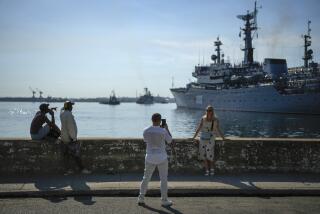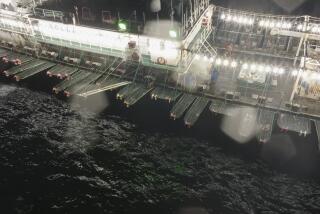40 Days at Sea on a Russian Research Ship
- Share via
USHUAIA, Argentina — I spotted a newspaper ad offering a cruise for seniors on a former Soviet Union oceanographic vessel, a 40-day voyage up the Pacific Coast of South and Central America coordinated by Boston-based Elderhostel Inc.
I’d been on conventional cruises, but I prefer smaller ships going to unusual places. The more I learned about this Americas cruise, the more I was enticed; its itinerary began in March in Ushuaia, Argentina (the fall season in South America), at the bottom of the civilized world, and ended in Nassau, the Bahamas. Another attraction were the four faculty specialists on board, all Americans, who would focus on history, marine life and wilderness exploration along the way. The price was $6,400 (at $160 a day, a bargain), including air fare from Miami, and all meals land excursions.
Ushuaia is the southernmost city in the world, and it was at its little port that I had my first view of our ship, the S.S. Sergey Vavilov. The Vavilov resembled an upscale freighter, though there was no mistaking its origins, with a Lego-like communications tower and 20 empty laboratories strategically located throughout the six decks. It was an odd cruising combination--78 senior American tourists and an elite Russian staff of bridge officers and crew. The officers were carry-overs from the glory days of the Vavilov as a state-of-the-art oceanographic research vessel. The mean age of my fellow passengers was about 60, with two jeans-clad 84-year-olds plus a retired cardiologist, an orthopedic surgeon and a former librarian from the Library of Congress.
The Vavilov’s amenities included a heated swimming pool, sauna, gym and handsome wood-paneled library. The first task, though, was sorting out our cabin assignments. Some cabins were quite spacious and attractively fitted, with private baths, and had once been occupied by marine scientists. Now they were taken by the couples among us. My cabin, on a lower deck, was small but provided a comfortable single bed, desk, easy chair and washbasin. A fully equipped bath and shower room, serving four of us, was just across the corridor. These smaller cabins, all facing outside, were lottery-drawn by the single passengers, and we were pleased to have the privacy without having to pay a single supplement.
The 1992 conversion of the Vavilov to charter pleasure ship by the funds-strapped USSR Academy of Sciences was painful. Our chief mate, Sergey Koralev, an electrical engineer formerly in charge of 22 highly skilled technicians, now ruefully characterized himself as “a hotel manager, checking the stocks of clean sheets.” The conversion had meant hasty translations of ship signs; one read: “Break glass for utmost urgency.”
But in the casual dining salon, our Swedish chef produced Western fare. We had a buffet breakfast of assorted fruit, purchased at local markets, with slices of ham, tomatoes, cheeses and cereals. Lunch was usually pasta, salad and fruit, and we loved the flan our chef served. Dinner was either a fish or meat course with potatoes or rice and wonderful baguettes. The only extra charge was for alcohol, and we bought bottles of South American wine for $10 or less.
The first complaint concerned the famed Beagle Channel, which, due to a fueling delay, we traversed blindly at night so we couldn’t see anything. But resentment soon faded when the Vavilov moved through the wind-swept Strait of Magellan. Long days were spent at the rail, everyone absorbed in the beauty of steep, rugged mountains and in our navigation through what seemed like pencil-thin passages. Giant petrels swooped low over the ship, and University of Washington marine biologist Al Erickson, a lecturer, was everywhere on deck, seemingly on greeting terms with every bird, fish and mammal we saw.
After three days we made our first port call at Puerto Natales, a Chilean town just over the Argentine border. We went by bus to Torres del Paine National Park, a place of jagged peaks, blue-white glaciers, pristine lakes and wildflowers. We hiked forested paths and watched as Andean condors, with 10-foot wingspans, glided overhead and a herd of guanaco grazed in a tiny meadow.
The next day at Puerto Eden, tucked among deep Chilean fiords, we made our first Zodiac landing. The rubber craft with their powerful engines slid into chilly gray seas. Suited up in our red life vests and our knee-high “Wellies,” we were facing a 3-foot leap from the heaving landing platform into the pitching Zodiac below. I was nervous, but one passenger, 84-year-old Millie, leaped in with the bravado of an elite parachute corps; the rest of us followed with mighty assists from the crew.
After crossing a tricky passage through crowded Chilean islets, the Vavilov made an unscheduled stop--it needed fuel--at Chiloe Island, where we wandered into a little fishing village. The market catered to locals, and it was odd to see imported kitchenware made in China and Korea, although the native handicrafts offered were impressive: sweaters, knits and other woolen goods. But the Russians were busy buying scarves and tablecloths and glittery hairbrushes for folks back home.
At Puerto Montt, our next stop, was the sea entrance to the Chilean Lake District, a playground of frigid lakes, snow-capped volcanoes and lush rain forests. I had a sense, at the end of this day’s exploration ashore, of overdosing on nature’s riches because the area was utterly unspoiled. We returned to the Vavilov to warm showers and cold drinks at what passed for the ship’s bar, a screened-off corner of the dining room.
Our days at sea were busy. The daily bulletin board listed time slots for “Whale and Bird Watching,” “Our Constellation Friends in the Night Sky” and afternoon cribbage games. Our faculty was hard-working and we were apt students. I spent hours in the library dipping into books and scientific papers (some in English) by scientists who had once worked on the ship. There were also lots of National Geographic films about the places we were visiting; everybody turned out for those. Continuing northward, the Vavilov crossed the Tropic of Capricorn, and the shore became increasingly arid.
In Peruvian waters, proved a wildlife wonderland. we were reluctant to leave the open decks, even to eat, for fear of missing out on pelicans flying in formation, cavorting sea lions and penguins, schools of bottlenose dolphins and red-plumaged terns wheeling overhead.
Meanwhile, George Llano, a former curator at the Smithsonian Institution, had us enthralled with the history and culture of the Americas’ indigenous peoples and the impact of Spanish colonization on them. As a result, when we toured Lima, with its cathedrals, colonial mansions, palaces and stupefying Gold Museum, it was hard not to see them as stunning but unholy relics of the conquests.
Soon after Lima, some passengers began appearing in the dining room, flushed with fever. The ship’s doctor, a briskwoman from Kiev, implored the infected folks to quarantine themselves in their cabins, but most did not. So what appeared to be a virulent flu swept through passengers and crew. The doctor scooped up antibiotics from various ports, and passenger Elizabeth Walker, a retired RN from Texas, made cabin calls. Gradually the contagion burned itself out as we sailed into the Northern Hemisphere.
As we neared Nassau, our final port, there was a farewell supper and many toasts as people recounted what had impressed them most on our trip. By then, we knew each other very well, and we all had shared a stunning variety of adventures.
(BEGIN TEXT OF INFOBOX / INFOGRAPHIC)
South American Sailing
Booking a seniors cruise: A voyage on a Russian ship, similar to the one I took, is offered from March 15 through April 24. Called “Pathways of the Conquistadors,” the cruise takes on passengers in Ushuaia, Argentina, then passes along the Pacific coast of South America and arrives in the Bahamas. The price is $8,505 per person. Cabins, which are doled out by lottery, vary in size and quality. Some have private baths, while other cabins share bathrooms. The price includes air fare to and from Miami, three meals a day on ship, and land excursions, with naturalists and lecturers accompanying each trip. At least one person in each passenger’s group must be age 55 or older; the minimum age for companions is 21.
For more information: Elderhostel Inc., 75 Federal St., Boston, MA 02210; telephone (877) 426-8056, fax (877) 426-2166, Internet https://www.elderhostel.org.
More to Read
Sign up for The Wild
We’ll help you find the best places to hike, bike and run, as well as the perfect silent spots for meditation and yoga.
You may occasionally receive promotional content from the Los Angeles Times.






